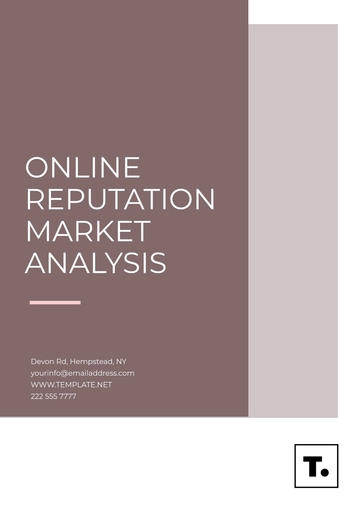LABOR MARKET ANALYSIS
I. Executive Summary
[Your Company Name] conducted a thorough analysis of the labor market trends in the United States from 2050 to 2055, focusing on workforce dynamics, skills gaps, and training needs. The analysis reveals critical insights into emerging job sectors, evolving skill requirements, and policy implications for workforce development strategies.
II. Introduction
This labor market analysis aims to assist the Department of Labor and Employment in understanding the changing dynamics of the U.S. labor market. By examining employment trends, demographic shifts, and technological advancements, the analysis provides actionable intelligence for shaping effective workforce policies and programs in the coming years.
III. Methodology
The analysis utilized a combination of quantitative and qualitative methods, including data from national labor surveys, industry reports, and expert interviews. Statistical analysis, trend forecasting, and stakeholder consultations were employed to ensure the accuracy and reliability of the findings.
IV. Labor Market Overview
Employment and Job Growth:
Employment Rate (%): Shows the proportion of employed individuals in the working-age population.
Job Growth Rate (%): Reflects the rate of new job creation, indicating economic expansion.
Indicator | 2050 |
|---|
Employment Rate (%) | 72 |
Job Growth Rate (%) | 2.8 |
Sectoral Distribution:
Displays the percentage of the workforce in key sectors like Technology, Healthcare, Manufacturing, and Others.
Helps understand the relative importance of each sector in terms of employment and economic contribution.
Sector | Percentage of Workforce (2050) |
|---|
Technology | 22 |
Healthcare | 18 |
Manufacturing | 12 |
Others | 48 |
V. Workforce Demographics
Age Group Distribution:
This table shows the percentage of workers in different age groups, providing insights into generational trends and workforce aging.
Educational Attainment:
Displays the percentage of workers with various levels of education, aiding in assessing skill levels and education-job correlations.
Gender Distribution:
Gender | 2050 (%) |
|---|
Male | 54 |
Female | 46 |
VI. Skills and Qualifications Analysis
Recommendations:
Upskilling Programs: Implement targeted training programs to develop digital and analytical skills among the workforce.
Certification Courses: Offer specialized certification courses to validate skills and enhance employability.
Collaborative Initiatives: Foster partnerships between academia and industry to co-create curriculum and training modules aligned with industry needs.
VII. Training Needs Assessment
Evaluation of Existing Programs:
Conducted an assessment of current training programs to gauge their relevance and effectiveness in meeting industry demands.
Proposed Enhancements:
Personalized Learning Pathways: Develop customized learning paths tailored to individual skill gaps and career goals.
Competency-Based Assessments: Implement assessments based on job competencies to measure skill acquisition and proficiency.
Continuous Feedback Mechanisms: Establish feedback loops to gather input from participants and industry stakeholders for ongoing program improvement.
Objective:
Enhance training programs to align with evolving job requirements, promote skill development, and ensure workforce readiness.
VIII. Job Market Projections
Shift towards Knowledge-Based Economies:
Projections suggest a transition towards knowledge-based economies, emphasizing sectors like renewable energy, healthcare technology, and advanced manufacturing.
Increased Opportunities:
Anticipate growing job opportunities in these sectors due to technological advancements and market demand.
Strategies for Talent Management:
Talent Retention: Implement strategies to retain skilled employees through career development and competitive benefits.
Talent Attraction: Attract top talent by showcasing opportunities for growth, innovative work environments, and work-life balance.
Agile Workforce Planning: Adopt agile workforce planning practices to respond quickly to market changes and emerging skill needs.
Objective:
Stay competitive in the evolving job market by aligning talent management strategies with industry trends and opportunities.
IX. Policy Implications and Recommendations
Adaptive Regulatory Environment: Create regulations that adapt to technological advancements and changing market dynamics to foster a conducive business environment.
Fostering Innovation Ecosystems: Establish innovation hubs, incubators, and collaboration platforms to support entrepreneurial ventures and technological innovation.
Promoting Lifelong Learning Initiatives: Encourage continuous learning and upskilling through lifelong learning programs, online platforms, and employer-sponsored training initiatives.
Public-Private Partnerships: Foster collaborations between government entities, businesses, and educational institutions to address skill gaps, promote innovation, and drive economic growth.
Incentives for Skills Development: Provide incentives such as tax breaks, grants, and subsidies to encourage businesses to invest in employee training and skills development.
Objective: Drive sustainable growth, enhance workforce productivity, and promote prosperity by implementing policies that support innovation, skills development, and agile governance in the labor market.
Prepared By : | [Your Name] |
Position : | [YOUR POSITION] |
Company Name : | [Your Company Name] |
Analysis Templates @ Template.net






























